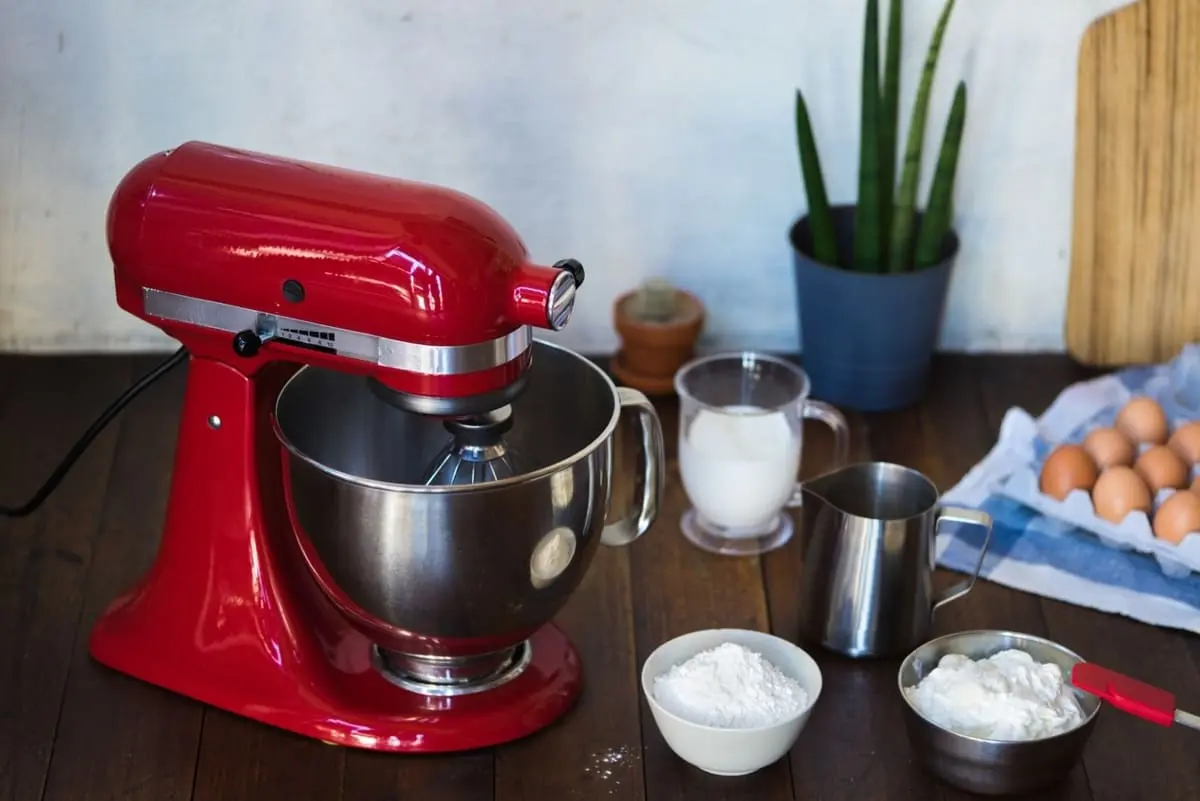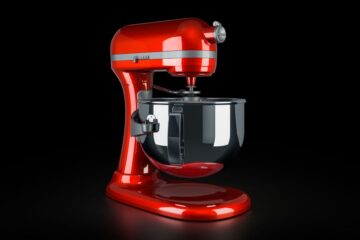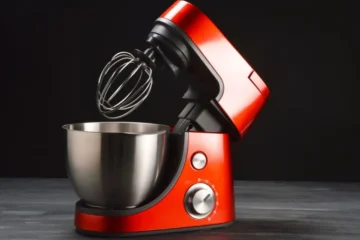Are you tired of kneading dough by hand or struggling to mix batter evenly? Look no further than a stand mixer! This kitchen appliance has revolutionized how we bake and cook, making tasks easier and more efficient. But with so many models and brands on the market, it can take time to figure out where to start.
In this blog post, we’ll dive into everything you need to know about what is a stand mixer for and how to choose the best one for you. Whether you have experience in baking or are a beginner, a stand mixer will take your kitchen game to the next level. Get ready to say goodbye to hand cramps and hello to perfectly mixed ingredients every time. So, let’s get started and learn about the magical world of stand mixers!
What Is A Stand Mixer?
A stand mixer is a kitchen appliance for mixing, kneading, and whisking ingredients. It typically features a powerful motor, a mixing bowl, and a variety of attachments such as beaters, dough hooks, and wire whisks. The mixer sits on a countertop and operates at multiple speeds to handle various tasks in baking and cooking. Stand mixers are often used to make bread dough, whipping cream, or mix cake batter.
Why Do I Need A Stand Mixer?
A stand mixer can be a helpful kitchen tool for mixing, beating, or kneading ingredients. It can save time and effort compared to using a hand mixer or mixing by hand. It can also handle larger quantities of ingredients. Some stand mixers also come with additional attachments, such as a dough hook, which can make bread-making easier.
What Is A Stand Mixer Used For?
A stand mixer is a versatile kitchen appliance used for various tasks. Here are some of the most common ways to use a stand mixer:
Mixing Batter
One of the most popular uses for a stand mixer is to mix batter for cakes, cookies, and other baked goods. The mixer’s powerful motor and multiple speed settings can easily and quickly mix all the ingredients together to create a smooth, consistent batter.
Kneading Dough
Stand mixers are also great for kneading dough for bread, pizza, and other baked goods. The mixer’s powerful motor and dough hook attachment can quickly and efficiently knead the dough, saving you time and effort compared to kneading by hand.
Whipping Cream
Whipping cream by hand can be tiring and time-consuming, but with a stand mixer, it’s a breeze. The mixer’s whisk attachment can quickly whip cream to the desired consistency, whether soft peaks for topping a dessert or stiff peaks for making meringue.
Beating Egg Whites
Stand mixers are also great for beating egg whites to create light and fluffy meringue or to add air to a cake batter. The mixer’s whisk attachment can quickly and efficiently beat egg whites to the perfect consistency.
Mixing Meat
Stand mixers can also mix ground meat for making meatballs or meatloaf. The mixer’s paddle attachment can quickly and efficiently mix the meat with other ingredients to create a uniform mixture.
Grinding and Shredding
Some stand mixers come with attachments for grinding meat or shredding cheese and vegetables. This can save you time and effort compared to doing these tasks by hand.
What Is A Stand Mixer Not Used For?
While a stand mixer is a versatile and helpful kitchen appliance, some tasks need to be recommended or well-suited. Here are a few things a stand mixer is not typically used for:
Blending Hot Liquids
Stand mixers are not recommended for blending hot liquids, as the heat can cause the mixture to splash out of the bowl and potentially burn the user. Instead, a blender or immersion blender is better suited for blending hot liquids.
Chopping or Slicing
A stand mixer is not designed for chopping vegetables, fruits, or other food items. A food processor or mandoline would be better suited for these tasks.
Juicing
A stand mixer is not designed for juicing fruits or vegetables. A juicer or the citrus press would be better suited for this task.
Mixing Heavy Doughs
While a stand mixer is great for kneading bread dough, it may need help to handle the very heavy or dense dough. In these cases, a heavy-duty or specialized dough mixer may be needed.
Mixing Small Quantities
A stand mixer is not ideal for mixing very small quantities of ingredients, as the beaters or whisk may not reach the bottom of the bowl, leaving some ingredients unmixed. A hand mixer or whisk would be better suited for small quantities.
- Can You Mash Potatoes In A Stand Mixer? (The Secret To Perfectly)
- Is A Stand Mixer Worth It? (Making The Right Decision)
What To Look For When Buying A Standing Mixer?
When buying a standing mixer, there are several factors to consider. Here are some things to look for when making your decision:
Power
The motor of a standing mixer is an important consideration. The higher the wattage, the more powerful the mixer will be. Look for a mixer with at least 350 watts of power, which will be sufficient for most household baking needs.
Capacity
Standing mixers come in various bowls, from 4.5 quarts to 8 quarts. Consider how much you typically bake and how many people you cook for to determine the right size.
Speed Settings
A good-standing mixer should have multiple speed settings, as this will give you more control over your mixing. Look for a mixer with at least 5-6 speed settings, including a slow setting for gentle mixing.
Accessories
Many standing mixers come with various accessories, including a whisk, beater, and dough hook. Some may also come with attachments for grinding, slicing, or juicing. Consider which accessories you will use most and look for a mixer that includes them.
Brand and Warranty
Choose a brand with a good reputation and warranty, as this will give you peace of mind that your mixer will last and be reliable. Check the warranty period and what it covers before making your purchase.
Design and Style
Standing mixers come in various designs and styles, from classic to modern. Consider your kitchen decor and personal style when choosing a mixer, as it will be displayed on your countertop.
Is Stand Mixer Better Than Kneading By Hand?
Generally, a stand mixer is better than kneading by hand for most people because it can save time and effort, produce consistent results, and handle larger quantities of dough. However, some people prefer kneading by hand for the tactile experience and control over the dough. Ultimately, the choice depends on personal preference and the specific recipe and situation.
Is A Stand Mixer Better Than A Food Processor?
It depends on the task you want to perform. A stand mixer is better for mixing, kneading dough, and whipping cream. At the same time, a food processor is better for chopping, slicing, and pureeing. Both appliances can be useful in the kitchen, and choosing one will depend on the specific task you want to perform.
What To Use A Kitchenaid Mixer For?
A KitchenAid mixer is a versatile kitchen appliance that can be used for a variety of tasks, including:
Mixing
The mixer comes with a beater attachment, perfect for mixing batter, dough, and even meatloaf.
Kneading
The mixer can be used for kneading bread dough, saving you time and effort compared to kneading by hand.
Whipping
The mixer’s whisk attachment can be used for whipping cream, egg whites, and other ingredients to create fluffy textures.
Grinding
With the right attachment, the mixer can grind meat, cheese, and other ingredients.
Pasta Making
You can also use a KitchenAid mixer to make fresh pasta dough and extrude various shapes with a pasta roller or cutter attachment.
Ice Cream Making
Using the ice cream maker attachment, you can create homemade ice cream, sorbet, and gelato.
What Stand Mixer Attachment For Cookies?
The best stand mixer attachment for making cookies is the flat beater attachment, also known as the paddle attachment. It is designed to mix the dough and batter evenly and thoroughly, which is essential for achieving the perfect cookie texture.
Can You Use A Regular Bowl With A Stand Mixer?
Yes, you can use a regular bowl with a stand mixer, as long as it is the appropriate size for the mixer and has a stable base. However, using the bowl designed specifically for the mixer may be more efficient and effective. To ensure safe and proper usage, it is important to consult the manufacturer’s instructions for your specific stand mixer.
Overall Thoughts On Stand Mixer
So, what is a stand mixer for? Essentially, it’s for all the tasks you’d normally have to do by hand. They’re the great life-changing convenience devices that make cooking easier, faster, and more efficient. And if you can afford one, we strongly recommend getting one! They’re amazing.
Frequently Asked Questions
What Is The Best Kitchenaid Stand Mixer For Home Use?
The KitchenAid Artisan Series 5-Quart Tilt-Head Stand Mixer has generally considered the best home use due to its versatility, durability, and ease of use. It has a powerful motor, a 5-quart stainless steel mixing bowl, and a wide range of available attachments that can handle various tasks, from mixing dough to shredding cheese.
What Stand Mixer Do Professional Chefs Use?
Professional chefs commonly use stand mixers from popular high-end brands such as KitchenAid, Hobart, and Ankarsrum. Among these brands, KitchenAid stand mixers are the most popular choice for professional chefs due to their versatility, durability, and wide availability of attachments.
What Is The Best Stand Mixer For Dough?
Several high-quality stand mixers are great for dough. Still, some of the best options are the KitchenAid Professional 600 Series, the Bosch Universal Plus Mixer, and the Ankarsrum Original Mixer. These mixers have powerful motors, large-capacity bowls, and sturdy construction, making them great for handling the heavy dough.
How Much Should I Spend On A Stand Mixer?
The cost of a stand mixer can vary depending on the brand, size, and features. A basic model can cost around $100 to $200, while high-end models with advanced features can cost over $500. Ultimately, how much you should spend on a stand mixer depends on your needs and budget.
What Is A Good Wattage For A Stand Mixer?
A good wattage for a stand mixer depends on the intended use. For light tasks such as mixing cake batter, a wattage of around 250-300 watts is usually sufficient. For heavier tasks like kneading bread dough, a higher wattage of 500 watts or more may be needed. It’s important to consider the tasks you’ll use the mixer for and choose a wattage that meets your needs.



